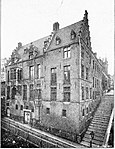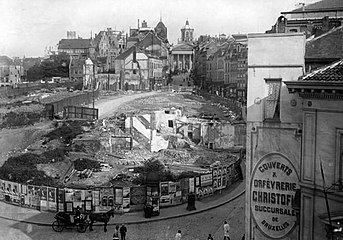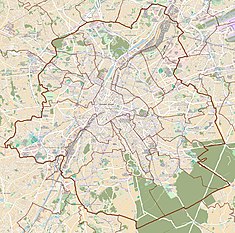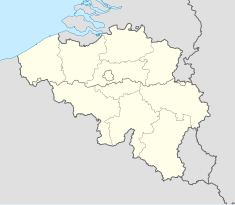Mont Des Arts Aka the Kunstberg Aka ââåthe Hill of the Artsã¢ââ
| Mont des Arts (in French) Kunstberg (in Dutch) | |
|---|---|
 The spire of Brussels' Town Hall seen from the Mont des Arts / Kunstberg | |
| Location | City of Brussels, Brussels-Upper-case letter Region, Kingdom of belgium |
| Coordinates | l°50′38″N 04°21′24″E / 50.84389°North iv.35667°E / 50.84389; 4.35667 Coordinates: 50°50′38″Northward 04°21′24″E / 50.84389°N iv.35667°E / 50.84389; iv.35667 |
| Built | 1954–1969 |
| Architect | Maurice Houyoux, Jules Ghobert René Péchère (garden) |
| Architectural style(s) | Modernism |
| Website | Official website |
| Location inside Brussels Prove map of Brussels Mont des Arts (Belgium) Show map of Belgium | |
The Mont des Arts (French, pronounced [mɔ̃dɛzaʁ]) or Kunstberg (Dutch, pronounced [ˈkʏnzdbɛr(ə)x] ( ![]() listen )), meaning "Hill/Mount of the Arts", is an urban complex and historic site in central Brussels, Belgium, including the Royal Library of Belgium (KBR), the National Athenaeum of Belgium, the Square – Brussels Meeting Centre, and a public garden.
listen )), meaning "Hill/Mount of the Arts", is an urban complex and historic site in central Brussels, Belgium, including the Royal Library of Belgium (KBR), the National Athenaeum of Belgium, the Square – Brussels Meeting Centre, and a public garden.
This site is located between the Rue Montagne de la Cour / Hofbergstraat and the Identify Royale/Koningsplein in its "upper" part, and the Boulevard de l'Empereur / Keizerslaan and the Place de l'Albertine / Albertinaplein in its "lower" part. It is served by Brussels Central Station.
History [edit]
Early history [edit]
The area of the Mont des Arts knew unlike affectations during its history. Jews settled in that location until the 14th century, as attested past the old Escaliers des Juifs or Ioode trappen ("Jewish Stairs"), a quondam series of four steep staircases leading to Brussels' upper town.[ane] Later, it used to exist a densely populated neighbourhood; the Saint-Roch Quarter (French: Quartier Saint-Roch, Dutch: Sint-Rochuswijk), centred around the at present-disappeared Rue des Trois-Têtes / Driehoofdenstraat [ii] and the former Place du Palais / Paleisplein (today'southward Place de la Justice / Gerechtsplein ), where Brussels' first courthouse was located.[3]

The palace and gardens of Coudenberg in 1659, L. Vorsterman the Younger

Map of central Brussels in 1695, showing the four Ioode trappen ("Jewish Stairs") in what was once known as the Jewish quarter

The "Jewish Stairs" in 1913 with the Hôtel Ravenstein on the left, earlier the major works in the city middle
Betwixt the 15th and the 18th centuries, the loma overlooking the neighbourhood was known equally the Montagne de la Cour / Hofberg ("Colina/Mount of the Courtroom") after the former Palace of Coudenberg as well located there. This impressive palace, famous all over Europe, had greatly expanded since it had first become the seat of the Dukes of Brabant, but it was destroyed past burn in 1731.[4] Only a small-scale section of the Rue Montagne de la Cour now remains below the Place Royale/Koningsplein.[5] The district's evolution over the next centuries raised one of the most complex questions in the town-planning history of Brussels: the link between the upper and the lower boondocks through the reorganisation of the Montagne de la Cour.[6]
Outset Mont des Arts (1910–1954) [edit]
By the end of the 19th century, King Leopold Two had the idea to catechumen the site into an arts' quarter and bought the whole neighbourhood. Various architects and urban planners were called upon to draw plans of the buildings which were to accommodate all kinds of cultural institutions.[vii] In the concurrently, the City of Brussels' then-mayor, Charles Buls, had laid out a minor plan for the Saint-Roch commune. His urbanistic and artful conceptions were totally opposed to those of Leopold Ii. The burgomaster wanted to preserve as much as possible of the quondam district, whilst the king imagined grandiose projects for his capital. Very isolated, Buls was not followed by the municipal council which voted for the king'due south project on 19 November 1894. Sickened, Buls resigned five years afterwards.[8] [6]
After the sabotage of the old buildings in 1897–98, the site turned into an urban void considering the project lacked sufficient finance. An agreement was finally signed in 1903 between the City of Brussels and the Belgian State for the construction of the Central Station and the creation of the Mont des Arts, at the same time as the complete reorganisation of the quondam Saint-Roch and Putterie/Putterij districts. To increase the area's entreatment during the Brussels International Exposition of 1910, the king ordered the French landscape builder Pierre Vacherot to design a "temporary" garden on the hill. It featured a park and a monumental staircase with cascading fountains and terraces descending the gentle gradient from the Place Royale down to the Boulevard de l'Empereur / Keizerslaan .[5] In 1910, a year after the death of Leopold II, the new park was inaugurated by his successor, King Albert I.
-

Destruction of the Saint-Roch Quarter in 1897–98 to make infinite for the Mont des Arts / Kunstberg
-

The Mont des Arts in the 1920s showing Vacherot's temporary garden
2nd Mont des Arts (1954–present) [edit]
Although the garden was conceived as temporary, it became a well-appreciated light-green surface area in the heart of the capital letter, but when the plans for the Mont des Arts came back by the stop of the 1930s, it had to be demolished to create a new foursquare every bit the heart of the urban renewal projection. The project was entrusted jointly to the architects Maurice Houyoux and Jules Ghobert. Betwixt 1956 and 1969, the park and its surroundings gave way to massive, severe geometric structures such every bit the Royal Library of Belgium (KBR) and the Congress Palace (now the Square – Brussels Meeting Centre). The new geometric garden, designed by the landscape architect René Péchère, was congenital upon the physical slab covering the Albertine auto park.[5] The structure of the Royal Library led to the complete disappearance of the old Palace of Orange-Nassau, with the exception of Saint George's Chapel. Faced with a wave of protests, information technology was decided in 1961–62 to integrate information technology into the library complex.[9] The inauguration took place in 1969.[vi]
Nowadays day [edit]
The Mont des Arts offers one of Brussels' finest views. Though the drinking glass and steel cube forming the new entrance to the convention centre has modified the upper part of the complex, the perspective created by Péchère has largely been preserved. From the elevated vantage point, the famous tower of Brussels' Town Hall on the Grand Place is clearly visible.[x] On a sunny twenty-four hours, the Koekelberg Basilica and even the Atomium can exist seen.[11] To the west rises the statuary equestrian statue of Albert I by the sculptor Alfred Courtens, inaugurated in 1951.[6] From the other end, looking upward towards the Identify Royale/Koningsplein, the dome of the Church of St. James on Coudenberg closes the perspective.
Major tourist attractions are located inside walking distance of the Mont des Arts: the Musical Instruments Museum (MIM), the Regal Museums of Fine Arts, the Royal Palace, and the Cathedral of St. Michael and St. Gudula.
-

-

-

The garden of the Mont des Arts during the twenty-four hour period
-

The same view during nautical twilight
Run into also [edit]
- List of parks and gardens in Brussels
- Due north–S Junction
References [edit]
Notes [edit]
- ^ "Localisation de 'Escalier des Juifs' sur 14 plans de Bruxelles". www.reflexcity.internet . Retrieved 29 October 2021.
- ^ "Localisation de 'Rue des Trois-Têtes' sur fourteen plans de Bruxelles". www.reflexcity.net . Retrieved 29 October 2021.
- ^ "Place de la Justice". www.reflexcity.net . Retrieved 29 October 2021.
- ^ Anagnostopoulos & Houssiau 2006, p. 3.
- ^ a b c "Kunstberg - History". www.montdesarts.com . Retrieved ix June 2018.
- ^ a b c d "Mont des Arts – Inventaire du patrimoine architectural". monument.heritage.brussels (in French). Retrieved 29 October 2021.
- ^ Liane Ranieri, Léopold II urbaniste, Brussels, Hayez (in French) (1973), p. 285
- ^ Demey 1990, p. 260.
- ^ Wasseige 1995, p. 26.
- ^ "Mont des Arts Gardens". visit.brussels . Retrieved ix June 2018.
- ^ Poel, Nana Van De. "The History of the Mont des Arts in one Minute". Culture Trip . Retrieved 15 August 2018.
Bibliography [edit]
- Anagnostopoulos, Pierre; Houssiau, Jean (2006). The one-time palace of Coudenberg. Brussels, city of Art and History. Vol. 42. Brussels: Éditions de la Région de Bruxelles-Capitale. ISBN978-ii-93045-706-2.
- Demey, Thierry (1990). Bruxelles, chronique d'une capitale en chantier (in French). Vol. I: Du voûtement de la Senne à la jonction Nord-Midi. Brussels: Paul Legrain/Cfc. OCLC 44643865.
- Wasseige, Manoëlle (1995). Le Quartier Royal. Bruxelles, ville d'Art et d'Histoire (in French). Vol. 15. Brussels: Éditions de la Région de Bruxelles-Capitale.
External links [edit]
- The Mont des Arts at the Brussels Tourist Board website


0 Response to "Mont Des Arts Aka the Kunstberg Aka ââåthe Hill of the Artsã¢ââ"
Post a Comment